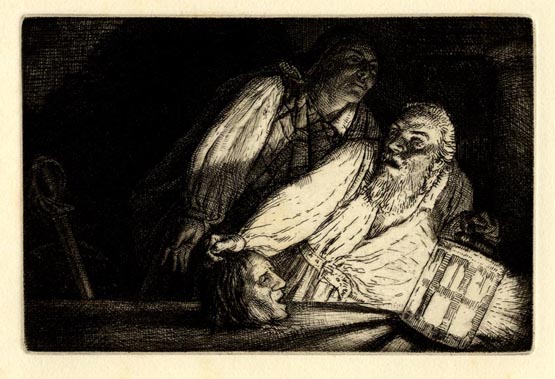back
WILLIAM STRANG
1859-1921

| IN THE PUBLIC DOMAIN ( 5 GALLERIES) |
| PARADISE LOST 1896 | |
| A BOOK OF BALLADS AND ETCHINGS 1898 |
| BARON MUNCHAUSEN | |
| ETCHING, ENGRAVING AND OTHER METHODS OF PRINTING PICTURES |
| THE PRAISE OF FOLIE | |
| PILGRIM'S PROGRESS |
| SINDBAD AND ALI BABA | |
| THE CHRIST UPON THE HILL |

| THE EARTH FIEND | |
| THIRTY ETCHINGS AFTER KIPLING |
| THIRTY ETCHINGS AFTER CERVANTES 1902 | |
| WESTERN FLANDERS |
| A BOOK OF GIANTS 1898 (sequence) | |
| A BOOK OF GIANTS 1898 (single spread) |
| VARIOUS PRINTS |

“Strang was a short, ruddy, broad shouldered, thickset Lowlander with a strong Scottish accent and a forehead like a bull, above which, the hair grew stiff and strong like a southern Frenchman’s. He was a staunch admirer of Legros: this was evident in his drawings and etchings. He had much of Legros’ remarkable power of design; his drawing was solid and energetic, and he showed a grim and lusty inventiveness in the composition of his subjects. He was an admirably equipped artist, and, at a time when the Glasgow School was becoming fashionable, he was for long under-estimated. In spite of a real curiosity for life, and a fertile imagination, an element of pastiche sometimes crept into his work, an infection caught perhaps from Legros. He was an ardent experimenter in many materials and methods – what he admired he at once attempted to do himself… He had just completed a set of etchings for The Pilgrim’s Progress and complained that no publisher would take them; they all wanted prettier things. He said he never used models for his subject etchings.” William Rothenstein, Men and Memories, 1931/2 Volume 1 p34. Rothenstein studied at the Slade (1886-1893) under Legros who gave him an introduction to Strang, his most accomplished ex-student. Many thanks to Michael T. Ricker who has made his collection available.
|
back
